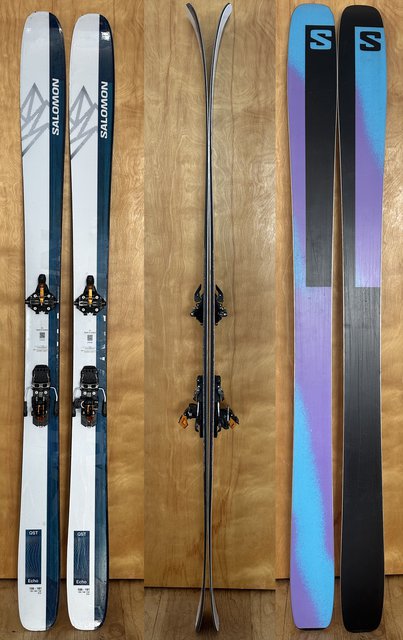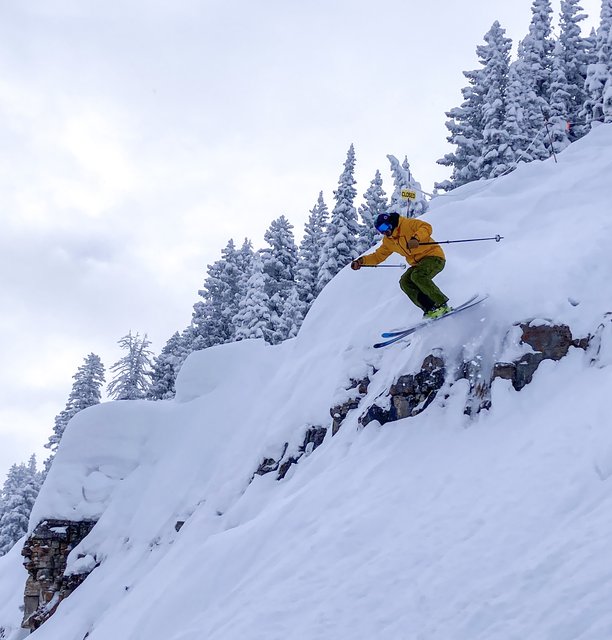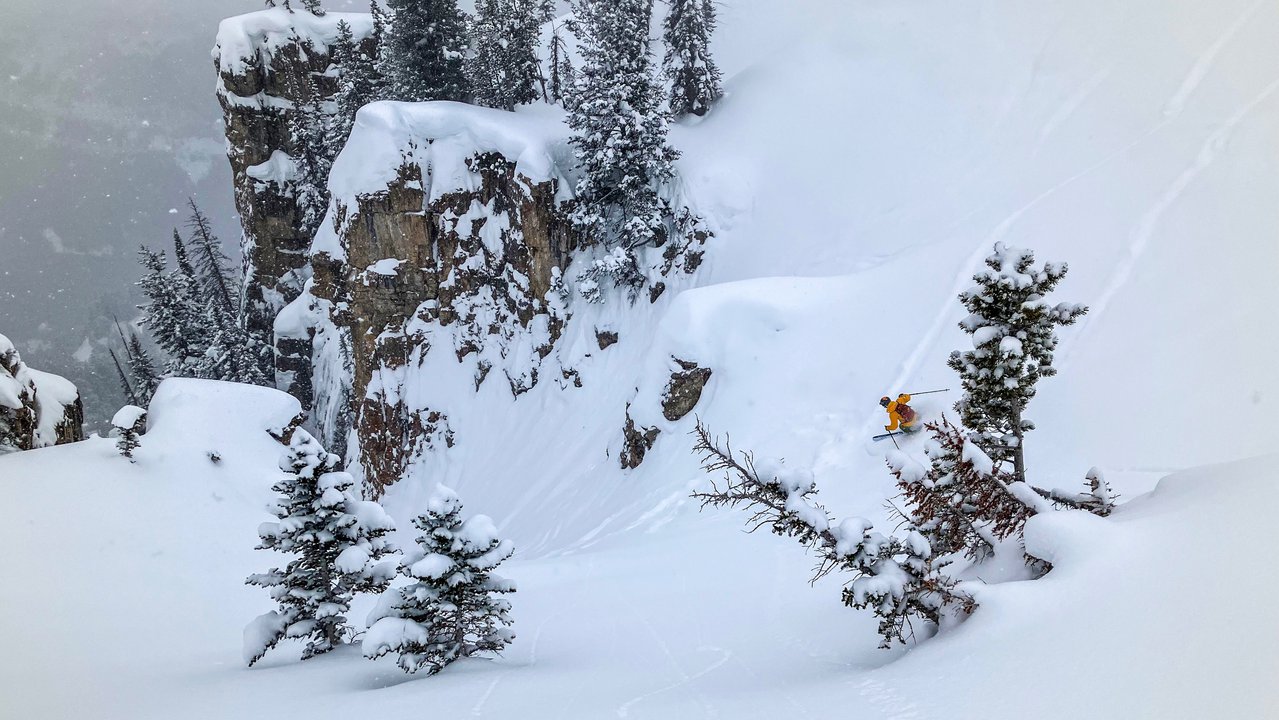Ski: Salomon QST Echo 106
Reviewer height/weight: 6’1”, 200lbs
Ski weights: 1803 g (only one ski weighed)
Length Skied: 181cm
Straight tape-pull length: 179.7 cm
Dimensions: 139-106-126
Radius: 19m (for 181 cm size)
Mounted: -8 cm from True Center
Bindings: Salomon Mountain Summit 12 BR
Salomon MTN Summit 12 BR
Weight:
-Toe: 136 g
-Heel: 178 g
-Brake: 101 g
-Total: 415 g
Release Value: 6-12
Heel Gap: 4 mm
Brake Width: 110 mm
Climbing Riser Heights (measured from center of heel pins):
Flat: -12 mm
Mid: + 10 mm
High: + 32 mm
Toe Pin Height: 37 mm
Heel Pin Height: 45 mm
Pin Delta: +8 mm
Locations: Teton Pass, Grand Targhee, Greater Teton Region
Conditions skied: Pow, chopped up pow, zipper crust, ice, groomers
Days skied: 10
Available now at: Salomon.com

Intro
I love this website, like, a lot. It’s where I came from, and it’s my favorite place to write. But sometimes I find myself having to get ahead of criticisms I know its readers will level. “It’s a dad ski” “Salomon doesn’t make twin tips anymore” “Go back to TGR”. Get it out of your systems, take a deep breath, ok, are we good?
Salomon’s QST 106 has been their leading all-mountain model for quite a few years now, so it should come as no surprise that they’ve added a tour version to the mix, the new QST Echo. The Echo shaves somewhere between one and two hundred grams off the regular QST, while keeping the same shape and profile.
Initially, I requested this ski for review because when one of the biggest players in the game releases a new ski, in one of the hottest market segments, you sorta gotta write about it. But after ten days on the Echo, and on Salomon’s newish MTN Summit 12 BR, I’m pretty in love. This ski is really frickin’ fun, and even if you’re a center mounted, twin tip only sorta skier, the QST Echo should be on your radar. So let’s get into it!
What’s it made out of?
The Echo version of the QST subs in a Karuba/Poplar core instead of the regular QST’s full Poplar layup. It also features basalt, and a cork “damplifier.” Damplifier is one heck of a word, I can’t wait to throw it around in casual conversation.
The big story here though is the 100% recycled sidewall material. The speckled portion livens up an otherwise straightlaced graphic, and the topsheet is also made from 30% recycled materials. Small steps, but appreciated.
Where did it come from?
The QST 106 has been around since 2016/17. And it’s worth noting that the claimed weight for that first iteration of the regular QST 106 was listed at 1900 g for the 188 cm version, which means that the 181 cm version probably weighed somewhere in the 1800 g range, just like the QST Echo does. The QST 106 has gained weight every year since then though, with the current inbounds version weighing a claimed 1980 g. I’ve skied a couple iterations of the QST 106 through that time frame, and have found all of them to be easygoing, intuitive skis that handle deep snow a lot better than you’d assume given their widths.
Length and Mount Point
After some deliberation I chose the 181 cm QST Echo 106. It’s shorter than I generally ski, I’m a solid 185-190 cm ski guy. But, the jump to the 188 cm version gains a lot of weight, and initially I planned on only touring on this ski. The QST Echo comes with two recommended mount lines, one at -8 cm from true center, for pin bindings, and one at -9 cm for Alpine bindings or Shift. I really like this philosophy, I’m a big fan of mounting skis further forward for lighter boots and bindings. It makes them easier to turn and control, and while it compromises the chargeability, that’s not the point with lighter pin bindings and boots.
-8 cm is further back than what I (and most readers of this website I’d assume) regularly ski. But, I did notice that it put almost exactly the same amount of ski in front of my boot as I have on my regular touring skis, 184 cm Moment Deathwish Tours mounted at -4 cm. So I wasn’t too worried about the length or mount point.
On Snow
Let me just preface this by saying, the QST consistently makes me smile when I’m on it. It’s a fun ski. If this is how dad skis are supposed to make me feel, sign me up.
My second day on the QST Echo 106 I was supposed to be working outreach for our local SAR team. But, it snowed a foot overnight, and I showed up to find our booth fully staffed. My supervisor told me to go ski, so I did. If I hadn’t been planning on working the booth all day, I would have brought up longer, wider skis. Instead I had the shortest, narrowest ski I’ve been on for a moment. With tech bindings, inbounds, a combo I do my best to avoid.

But powder frenzy bit me, and I took off, chasing a more aggressive skier who knows my home hill even better than I do. We charged, hard all morning, plundering fresh powder, working the stashes, and hitting rope drops into steeper terrain as they opened. And holy hell, the QST Echo 106 was a blast. This ski floats much better in untouched powder than any 106 underfoot, 181 cm ski has any right to. When things got a little flat and deep, I did find myself working a little harder to keep my tips up, which was unsurprising.
What really stuck out to me was how hard I could ski the QST Echo in soft, chopped up snow. I know, this is a touring ski, and I’m talking an awful lot about how it did skiing off a chairlift, but I can’t think of another 1800ish gram ski I’ve been on that offers this level of suspension when skied hard in variable snow. It’s absurd.
I pushed the QST Echo 106 as hard as I’d push any 2000g inbounds ski, and it never let me down. It doesn’t get floppy at higher speeds in chopped up snow, it absorbs landings into bumps with ease, and it pivots and turns easily in tighter terrain. This is a really fun day-after-the-storm ski.

Since that day, I’ve skied the QST Echo in a wide variety of conditions: dust on crust, dust on zipper crust, bottomless pow, mank, and creamy pow. And in all of those situations it’s been extremely predictable. You tell it to turn and it does, in an easy, controlled manner, even when the snow is crappy and unpredictable.
It was only at very high speeds, when trying to make bigger radius hero turns that the QST Echo really stuttered. This is not the ski to be on if your goal is to make as few turns as possible, leveling small trees and children in your way. But, if you want a ski that makes you feel like a better skier than you are, in most conditions, and is light enough to tour on, the QST Echo 106 is a great option.
More “Newschool” skiing.
With a recommended mount point of -8 cm from center, this is not a jibby, ski switch all day kind of ride. Obviously. But, it’s surprisingly playful. It’s easy to press into the tails and pop over or tap features, something that I’ve struggled with on similarly directional skis. Similarly, the tips lean into a butter surprisingly well, once you get used to the less centered stance. And it’s light, so side hit 360s are a breeze. It doesn’t respond well to switch landings in pow, something I found out quickly, but it does have enough tail splay to make switch riding on firm snow reasonably easy and predictable.

There’s an old trope that park skiers get old and take their park tricks to the backcountry. But more and more, I see young skiers who occasionally lap the park, but spend a lot of time learning tricks off booters into pow, or natural hits. And for this crop of skiers, the QST 106 makes a lot of sense. Bump the mount forward a cm or two, and you’ve got a plenty playful ski for the “cork 7s off cliffs” set.
Will it make the whole mountain your playground? Maybe, it really depends on what sort of playground you’re looking for though.
Touring
1800ish g is a sweet spot for touring skis these days. Light enough for any objective, but with enough heft to handle any snow. The QST Echo 106 personifies that combination. I wouldn’t hesitate to head out for a 10,000-foot vert day on the Echo, but I’d also be happy to ski manky, crappy variable snow on it as well. It skins easily, and offers the sort of predictability that means I can focus on getting back to the car, not what my ski is doing when conditions get bad. That’s huge.
About the Binding
The QST 106 Echos that I reviewed came mounted with Salomon’s new Mountain Summit 12 BR binding. I’ve described its predecessor, the regular MTN binding, as being underrated. It’s affordable, durable, and reliable. So far the new version builds on that.
It has adjustable lateral heel release (6-12 on the 12 version), instead of the “man, woman, or expert” system the MTN had. It does continue to use a U spring to control vertical release though, with a set value. And I did find that the heel is harder to rotate by hand than competitors like ATK. Not a big deal, and only necessary for flat approaches, since the brake lock and risers function independent of this rotation, but worth noting.
It has the same mount pattern, brakes and brake lock as the MTN, which I appreciate. And, big news, the brakes now sit on a separate plate from the heel of the binding, so you can swap between braked and brakeless versions without buying any parts. I’ve never had the brakes pop down, and the brake lock acts as a de facto freeride spacer, leading to better power transfer. These ski better than most other tech bindings I’ve been on. They feel solid and powerful without being harsh.
The heel risers are nice and high, and easy to actuate with a pole. But I did find that, just like the old MTN, the high riser has a tendency to flop back when breaking trail in deep snow. That’s frustrating on a brand new binding.
While the new Summit has the same ramp as the old version (8 mm), by my measurements at least, the toe and heel are each 6 mm higher off the ski than on the old version. That’s interesting because I really like this toe. It has a clever anti-balling plate, reminiscent of a crampon, under the toe springs. I think this is brilliant, it’s a simple, lightweight way to combat icing. And the toe has a more “inbounds” ride quality than other tech toes I’ve been on, including ATKs. It absorbs small chatter well, and has better retention characteristics than I’m used to with tech toes. I have a tendency to throw small, whiplashey 360s off of side hits, and invariably I pop out of my tech toes and leave my skis behind. This never happened on the Summit.
But back to that pin height. The higher toe pins are interesting, because, if you’re a nerd like me who likes to mix and match toes and heels, and also likes flatter-delta bindings, the Summit toe is high enough that you could match it with an ATK or Ski Trab (or old MTN) heel and get something lightweight, with great retention, and a pretty flat delta without any shims.
I have many more thoughts about these bindings, but I’ll save those for another day. They were a great match for the Echo.
What bindings should I put on these? And what length should I get?
Well, that depends on what you want to do. For an all-around touring setup, I’d be happy with the Summit binding they came with, or an ATK FR 14. For big days, I’d go minimalist with a race+ binding like the ATK Haute Route. And you could convince me to put Shift or an alpine binding on the Echo, but only if I sized up to the 188. For me, the 181 doesn’t call for a heavier, more aggressive binding, so why hamper it with one?
If I was looking for an exclusively inbounds ski, as a 6’1” 200lb person, I’d opt for the 188 cm regular QST 106. If I was looking for an all-around touring ski, the 181 cm QST Echo would be my weapon of choice. And if I was looking for one ski to ski inbounds and tour on, the 188 cm QST Echo with Shift mounted at +1 or 2 would be an easy call. So, while it seems like there’s a bit of an odd size gap with the QST line, I was surprised to find how well the Echo fills it.
Compared to the Atomic Bent 110
Two Amer brand skis locked in a battle for dominance! Sure, on paper, they’re pretty dissimilar. The Echo is much more directional looking, with a less symmetrical shape and rearward mount point. And to a certain extent, that makes choosing between them easy. If you like landing switch, spinning a lot, and taking the occasional park lap, the Bent 110 is the easy call.
But, if you only ski and land switch very occasionally, you value lighter weight, and you tour more, the QST Echo makes a compelling case for itself. It’s lighter, it handles variable snow better than the Bent 110, I found it to be slightly more predictable and easy to drive than the Bent 110, and similarly stable. And the QST Echo doesn’t suffer as badly from the size gap it shares with the Bent 110. On the 188 Bent 110 I constantly found myself wishing for a 184 or 185. It just felt a touch unwieldy, extra length that didn’t provide a worthwhile payback in stability or float. But the 180 Bent 110, with its more centered mount point, is way too short for me, whereas the QST Echo 106, in a 181, with its -8 cm mount point, is a nice analogue to the 184 cm, more centered skis I spend a lot of time on.

I promise I skied plenty of bad snow on this ski, but it's more fun to take pictures on the great days!
And oddly, I never felt like the 188 Bent 110 was “better” in deep snow than the QST 106 Echo, even though the Echo was 7 cm shorter and 4 mm narrower. The QST Echo is a shockingly fun pow ski, it’s loose, has more float than you’d expect, and lets you make the most of deep days. But every time I skied pow on the Bent 110, I found myself missing the Bent 120. That said, I’d love to see an Echo version of the QST Blank sometime in the future.
Who’s it For?
Dads who tour, hur hur hur! Nah, but actually, a lot of folks will get along really well with the QST Echo 106. It’s a supremely predictable ski, at a respectable weight. It responds well to a centered stance, or a more forward, aggressive technique. No, it doesn’t have the flashiest graphics or the trendiest buzzwords. But, if you’re looking for a ski that will get you from the car to the summit, and back again, with no nasty surprises, and in fact, a few pleasant ones, the QST Echo 106 fits the bill.
Conclusion
The Salomon QST Echo 106 fits our current moment exceptionally well. It’s lightweight, versatile, predictable, and above all, more fun than you’d expect. It’s a great example of what a do-it-all touring ski should look like in 2023.


Comments